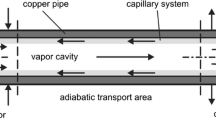Conclusions
In forging-die production there is a considerable range of forging dies which are promising for a changeover into advanced heat treatment involving bulk temper hardening and surface hardening using induction heating. The heat treatment suggested provides a saving of material resources as a result of improving the life of forging dies by a factor of 1.5–3 depending on the grade of die steel.
As a result of induction hardening of forging dies, after temper hardening close to the boundary of the hardened layer a zone of reduced hardness forms whose unfavorable effect may be reduced by using before induction surface hardening bulk warming in a furnace or deep induction heating with a reduced energy concentration in the heating zone to the tempering temperature in the temper hardening cycle.
In order to improve the uniformity of induction surface hardening for dies with a complex working shape it is desirable to use heating at reduced power with an increase in heating time.
Similar content being viewed by others
Literature cited
S. A. Dovnar, Thermomechanical Hardening and Failure of Bulk-Forming Dies [in Russian], Mashinostroenie, Moscow (1975).
Inventor's Certificate No. 411666 USSR, MKI N 05b 5/18; S 21d 9/60. Device for Induction Surface Heating of Components.
Inventor's Certificate No. 499327 USSR, MKI S 21 D 1/66; N 05 V 5/18, Device for Induction Heating of Components.
Inventor's Certificate No. 461956 USSR, MKI S 21d 9/22; S 21d 1/10, Method for Heat Treating Dies.
S. A. Dovnar, I. F. Kurovskii, and E. I. Sidor, "Structural strength of bimetallic forging dies after thermomechanical calibration," Izv. Akad. Nauk BSSR, Ser. Fiz.-Tekh. Nauk, 3–9 (1982).
A. G. Vinitskii, N. E. Yanenskii, V. V. Moshnyagul, et al., "Effect of structure on the wear resistance of dies made of steel Kh12M", Metalloved. Term. Obrab. Met., No. 2, 74 (1971).
A. S. Kholin, A. I. Abramov, A. N. Chekhovoi, and V. B. Yakovlev, "Electrothermal treatment of highly-alloyed die steels", Metalloved. Term. Obrab. Met., No. 11, 54–56 (1978).
A. I. Samokhotskii, Heat Treatment Technology [in Russian], Mashgiz, Moscow (1962).
K. Z. Shepelyakovskii, I. N. Shklyarov, and V. D. Kal'ner, "Surface hardening with deep induction heating, a promising method for heat treating steels", Metalloved. Term. Obrab. Met., No. 5, 33–37 (1966).
Additional information
Physicotechnical Institute, Academy of Sciences of the Belorussian SSR. Translated from Metallovedenie i Termicheskaya Obrabotka Metallov, No. 8, pp. 37–41, August, 1987.
Rights and permissions
About this article
Cite this article
Dovnar, S.A., Kadnikov, S.A. Heat treatment of forging dies. Met Sci Heat Treat 29, 601–606 (1987). https://doi.org/10.1007/BF00763115
Issue Date:
DOI: https://doi.org/10.1007/BF00763115



